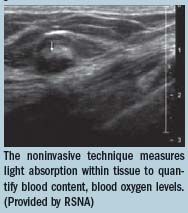US-guided optical technique reduces biopsy rate
An ultrasound-guided diffuse optical technique may lower the rate at which women undergo breast biopsies for suspicious lesions, according to a study published in Radiology.
An ultrasound-guided diffuse optical technique may lower the rate at which women undergo breast biopsies for suspicious lesions, according to a study published in Radiology.
Diffuse optical tomography is a noninvasive imaging technique that measures light absorption within tissue to quantify blood content and blood oxygen levels. Once ultrasound locates the lesion, DOT is performed by shining infrared light into the area and measuring light absorption at two optical wavelengths.

In the study, 178 consecutive women underwent the technique on a previously identified solid lesion followed by a biopsy. Researchers computed total hemoglobin levels from the light absorption measured at two wavelengths and correlated the measurements with biopsy results. Tissue sample examinations revealed two in situ carcinomas, 35 carcinomas that measured <2 cm, 24 carcinomas >2 cm, and 114 benign lesions (2010;256:367-378). The sensitivity (92%) and specificity (93%) of the technique were greatest when evaluating cancers <2 cm in size.
DOT holds promise as an adjunct to diagnostic mammography and ultrasound for distinguishing early stage invasive breast cancers from benign lesions, the researchers said.
Emerging AI Algorithm Shows Promise for Abbreviated Breast MRI in Multicenter Study
April 25th 2025An artificial intelligence algorithm for dynamic contrast-enhanced breast MRI offered a 93.9 percent AUC for breast cancer detection, and a 92.3 percent sensitivity in BI-RADS 3 cases, according to new research presented at the Society for Breast Imaging (SBI) conference.
The Reading Room Podcast: Current Perspectives on the Updated Appropriate Use Criteria for Brain PET
March 18th 2025In a new podcast, Satoshi Minoshima, M.D., Ph.D., and James Williams, Ph.D., share their insights on the recently updated appropriate use criteria for amyloid PET and tau PET in patients with mild cognitive impairment.
Can Abbreviated Breast MRI Have an Impact in Assessing Post-Neoadjuvant Chemotherapy Response?
April 24th 2025New research presented at the Society for Breast Imaging (SBI) conference suggests that abbreviated MRI is comparable to full MRI in assessing pathologic complete response to neoadjuvant chemotherapy for breast cancer.
Clarius Mobile Health Unveils Anterior Knee Feature for Handheld Ultrasound
April 23rd 2025The T-Mode Anterior Knee feature reportedly offers a combination of automated segmentation and real-time conversion of grayscale ultrasound images into color-coded visuals that bolster understanding for novice ultrasound users.